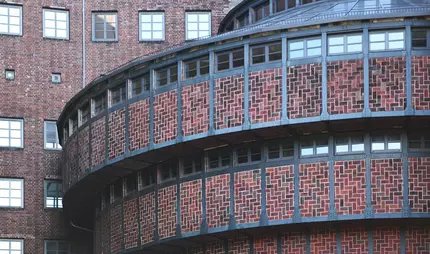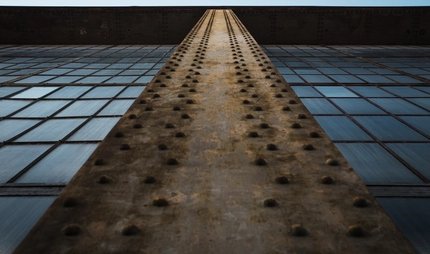
Gasometer Fichtestraße
Berlin's oldest gas tank made of stone
An unusual building stands in the centre of Kreuzberg: the gasometer on Fichtestraße, also known as the Fichtebunker.
Circular buildings are rather rare, which makes the stone gasometer, a huge cylinder on Fichtestraße in Kreuzberg, all the more impressive. If you look closely, you can recognise a steel and glass construction on the roof.
The beginnings of the building go back to a time long before Berlin became the electropolis of the 1920s.
It wouldn't work without gas
Without a gas supply, the city of Berlin would probably not have become one of the most important metropolises of modern times. It's hard to imagine today, but for most of its history, Berlin was pitch black at night. Only a few oil lamps hung outside the doors here and there.
This only changed in 1826, when the first gas lanterns were lit on the boulevard Unter den Linden. The light came "not in meagre flames, but in hand-width streams" wrote the Vossische Zeitung enthusiastically.
In the beginning, the lanterns still had to be lit by hand. The new profession of lamplighter was born. it was not until the 1920s that the gas lanterns were automatically controlled by remote pressure wave igniters.

More light on the Spree
One reason for systematically illuminating the streets was the desire to curb night-time crime and prostitution. For citizens, night suddenly became day and the artificial light completely changed life in the city.
Workers could toil in factories regardless of daylight, night owls could stroll along brightly lit boulevards in the evening.
Berlin was expanding and needed more light, and from 1870 it significantly expanded its gas pipeline network.
But the storage of gas was - then as now - not without danger. The city therefore developed areas outside its building limits, including the Köpenicker Feld near the Hasenheide - today the neighbourhood of Kreuzberg is located here.
The last of four gas tanks
The building on Fichtestraße is the last remaining stone gasometer in the whole of Berlin. Originally, the gas tank facility consisted of four almost identical tanks.
The gasometer was built in 1883/1884 according to plans by the architect Eugen Reissner. At the time, Reissner was a "technical conductor", i.e. a senior technician at the municipal gasworks. His aim was to design buildings that met the technical requirements but were also aesthetically pleasing.
The shape and design of the gasometer is a tribute to the most famous Berlin architect of the early 19th century: Karl Friedrich Schinkel.
The façade of the huge brick cylinder is broken up by arched windows. Alternating layers of light-coloured and red bricks adorn the outer walls, while a so-called Schwedler dome was originally enthroned on the roof:
A dome makes a career
The engineer Johann Wilhelm Schwedler was responsible for the dome and the statics at the time. His innovative designs were epoch-making: the flat-arched iron dome had a simple structure and weighed less than the conical roofs that were common at the time.
The combination of steel rings, diagonal struts and a covering made of wood and tar paper was light and stable enough to span the enormous diameter of 56 metres. The Schwedler dome thus made it possible to quadruple the storage volume.
Other cities such as Hamburg, Leipzig and Vienna imitated Schwedler's model.
Today, only the scaffolding of the Schwedlerkuppel can still be seen on the Fichtebunker.
From gasometer to war bunker
The gasometer supplied Berlin's lanterns with gas for over fifty years.
in 1936 , the National Socialist government took it out of service and converted it into a mother and child bunker four years later. The old outer walls were simply used as cladding for the new concrete bunker.
Inside, where there had previously been a cylinder full of gas, there were now 750 windowless rooms. Families sought shelter here during air raids, but only people with an authorisation card were allowed in. The bunker with its almost 2 metre thick reinforced concrete walls could hold up to 7000 people.
Regina Schwenke, one of the children from back then, remembers: "You could feel a slight tremor during heavy attacks. But all in all, you felt absolutely safe in the bunker." The massive building was a comparatively safe haven in the noise and turmoil of the bombing campaign. "You could count yourself lucky if you got a place here," says Regina Schwenke.

From bunker to reception centre
After the war, the building had a chequered history. Among other things, it served as a reception centre for refugees, people who had been bombed out and soldiers who had returned home. However, the cell-like rooms suggested other uses: just one year later, in 1946, ayouth detention centre was set up in the Fichtebunker.
In the 1950s, the Fichtebunker became a shelter for the homeless, and "republic refugees" from the GDR were also housed here. The 1962 report "Bunker of the Hopeless" states: "The building is a circle, and life inside is a circle. Round tours and no daylight. Here the soul loses its melting...."
After the Wall was built in 1961, fewer refugees came from the East and the asylum closed. For a long time, the state of Berlin used the building as a so-called Senate reserve in order to be prepared for a second blockade of West Berlin. The building on Fichtestraße was now filled with basic foodstuffs, medicines and raw materials.
After reunification, the Fichtebunker stood empty for years. in 2006, the building became private property and the architect Paul Ingenbleek built his Circle House. He removed the massive entrance structures of the former bunker and opened up the Schwedlerkuppel. All that remained was its steel frame, which spanned ten terraced houses arranged in a circle.
The interior of Berlin's largest bunker, which has been preserved in its original state, is shown in exciting guided tours organised by Berliner Unterwelten:
Information about your visit
You should wear warm clothing for the 90-minute tour, as the temperature in the bunker is only around 10 degrees Celsius all year round. You should also wear sturdy shoes. The tour is not suitable for children under the age of 7.
The best way to get to the Gasometer Fichtestraße is to take underground line 7 to the Südstern stop and walk a few minutes from there. To explore the city, we recommend the Berlin Welcome Card for public transport.



